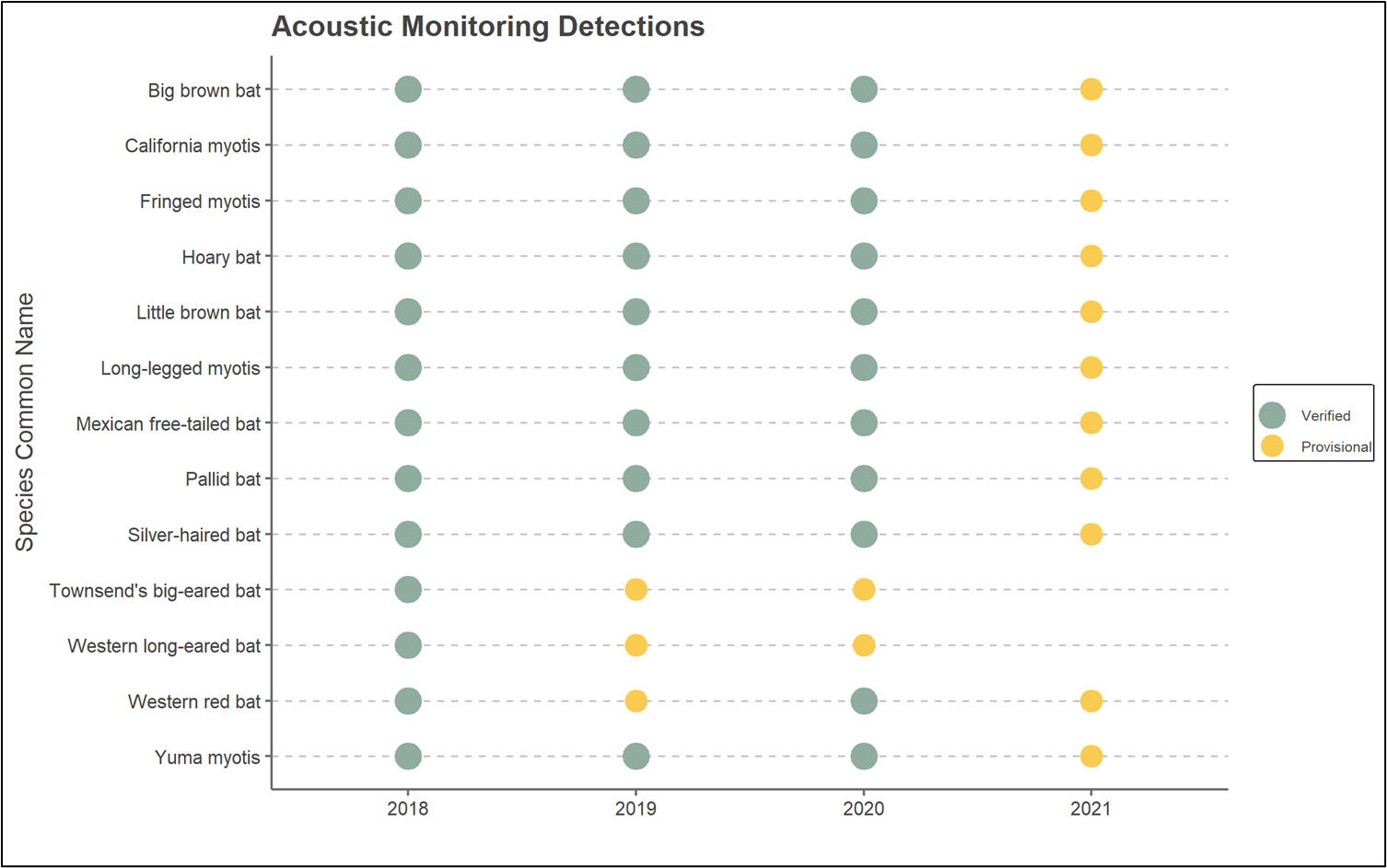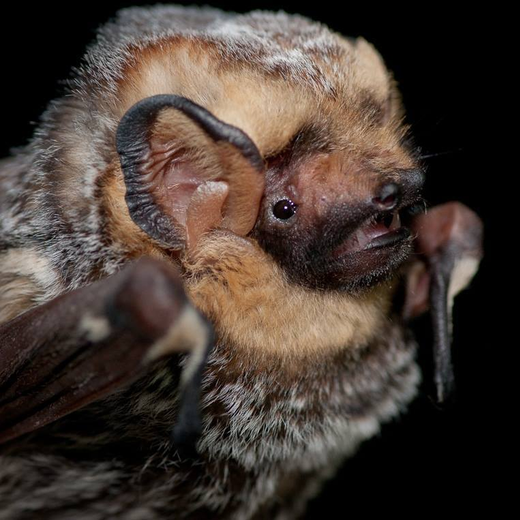Why Was This Indicator Chosen?
Although they represent one-fifth of the planet’s mammal diversity, 80% of the world’s bat species are either not well understood or are in need of conservation (Frick et al., 2019). Mt. Tam supports a diverse bat community with 13 known species; however, until recently, studies were limited (GANDA, 2003; Heady & Frick, 2004).Bats are good indicators of ecological health because, in addition to being top predators of nocturnal insects, they are sensitive to a wide range of environmental factors, including climate change, habitat loss and fragmentation, pesticides and insect availability, disease, drought, wildfires, and human disturbance (especially at breeding colonies). They use a variety of roosting habitats (trees in various stages of decay; fallen wood and snags; rock outcrops; caves; and mines, bridges, and other human-made structures) and often return to the same roosts annually. Three local bat species have been designated as state Species of Special Concern.
What is Healthy?
- The full suite of expected bat species is present.
- Species diversity is high and distributed at stable or increasing levels in appropriate habitats across the landscape.
- Local populations remain stable or improve within a range of expected natural fluctuations and are resilient to ongoing and emerging stressors.
- Suitable habitat diversity is protected or enhanced through actions to maintain landscape connectivity and mosaics that support resident and migratory species,maternity roosts, and foraging.
What Are the Biggest Threats?
The biggest threat to Marin County’s bats are habitat loss and roost disturbance.
What is The Current Condition?
The current status of Bats around Mt. Tam is Good. The Marin County-wide bat monitoring program, initiated in 2017, has provided the preliminary data used to incorporate them in this 2022 update. Early results indicate that their condition is good, with a steady trend based on metrics of species richness and species presence and distribution. Thanks to this new monitoring program, we now know that Mt. Tam is home to all bat species expected to be in our region and hosts some important maternity colonies. Long-term monitoring of these bat populations may provide important insights into the ways in which biological communities are changing over time. o date, monitoring efforts indicate that bats’ current condition within the area of focus and throughout the county is good, based on the following:
- Acoustic monitoring has documented the expected suite of species.
- Summer telemetry has revealed previously undocumented maternity colonies for a variety of species, including pallid bats, big brown bats, and California and Yuma myotis, with some large colonies hosting more than 200 bats.
- Winter telemetry has detected a diversity of bat activity and identified the roosts of several species, including pallid bats, big brown bats, California and Yuma myotis, and a previously undocumented wintering area for female hoary bats, which is a novel finding throughout this species’ range.
- White nose syndrome has not been found in Marin County, despite recent documentation of the disease’s causative fungal pathogen Pseudogymnoascus destructans (Pd) at several locations across California. White nose syndrome is a fast-spreading fungal disease that has decimated populations of some North American bat species.
What is the Current Trend?
The trend is No Change.
How Sure Are We?
Our confidence level is Moderate due to several factors. Monitoring effort may fluctuate from year to year. In addition, some species are less common and so may inherently have more variability. In addition, identifying bat species by their acoustic call files can be a challenge, even for a bat biologist. Classification software, such as SonoBat, uses highly sophisticated models to identify the species that made the acoustic file, but an expert still needs to fully confirm the identification with a high level of confidence.
What is This Assessment Based On?
- Marin County bat acoustic pilot study 2017.
- Marin County bat monitoring data 2018–2021.
- Annual monitoring of maternity roosts, including Townsend’s big-eared bat roosts.
What Don’t We Know?
Key information gaps include:
- Distribution and Abundance: The overall population size for Marin County’s bat species is unknown. We also do not know whether species currently described as rare were previously widespread, or if for some species, the county is marginal habitat and/or at the edge of their range.
- Habitat Use: How migratory bats, including hoary bats, western red bats, and silver-haired bats are using this landscape to support their overall lifecycles.
resources
Adams, R. A., & Hayes, M. A. (2008). Water availability and successful lactation by bats as related to climate change in arid regions of western North America. Journal of Animal Ecology, 77(6), 1115–1121. https://doi.org/10.1111/j.1365-2656.2008.01447.x
Adams, R. A., & Hayes, M. A. (2021). The importance of water availability to bats: Climate warming and increasing global aridity. In B. K. Lim, M. B. Fenton, R. M. Brigham, S. Mistry, A. Kurta, E. H. Gillam, A. Russell, & J. Ortega (Eds.), 50 years of bat research (pp. 105–120). Springer. doi: 10.1007/978-3-030-54727-1_7
Bat Conservation Trust. (n.d.). Bats and cats: Advice for responsible cat owners. https://cdn.bats.org.uk/uploads/pdf/Cats_and_Bats.pdf?v=1541085201
Becker, D. J., Speer, K. A., Korstian, J. M., Volokhov, D. V., Droke, H. F., Brown, A. M., Baijnauth, C. L., Padgett-Stewart, T., Broders, H. G., Plowright, R. K., Rainwater, T. R., Fenton, M. B., Simmons, N. B., & Chumchal, M. M. (2021). Disentangling interactions among mercury, immunity and infection in a Neotropical bat community. Journal of Applied Ecology, 58(4), 879–889. https://doi.org/10.1111/1365-2664.13809
Bergstrom, B., & Smith, M. (2017). Bats as predominant food items of nesting Barred Owls. Southeastern Naturalist, 16(1), N1–N4. https://doi.org/10.1656/058.016.0110
Cheng, T. L., Reichard, J. D., Coleman, J. T. H., Weller, T. J., Thogmartin, W. E., Reichert, B. E., Bennett, A. B., Broders, H. G., Campbell, J., Etchison, K., Feller, D. J., Geboy, R., Hemberger, T., Herzog, C., Hicks, A. C., Houghton, S., Humber, J., Kath, J. A., King, A., … Frick, W. F. (2021). The scope and severity of white-nose syndrome on hibernating bats in North America. Conservation Biology, 35(5), 1586–1597. 10.1111/cobi.13739
Frick, W. F., Kingston, T., & Flanders, J. (2019). A review of the major threats and challenges to global bat conservation. Annals of the New York Academy of Sciences, 1469(1), 5–25. https://doi.org/10.1111/nyas.14045
Garcia & Associates [GANDA]. (2003). Structural surveys for bats for the Marin Municipal Water District Mt. Tamalpais watershed [Unpublished report]. Prepared for Marin Municipal Water District.
Heady, P. A., & Frick, W. F. (2004). Bat inventory of Muir Woods National Monument (Final report). National Park Service. https://irma.nps.gov/DataStore/DownloadFile/152577
Long, J. W., Lake, F. K., & Goode, R. W. (2021). The importance of indigenous cultural burning in forested regions of the Pacific West, USA. Forest Ecology and Management, 500(3), 119597. https://doi.org/10.1016/j.foreco.2021.119597
Steel, Z. L., Campos, B., Frick, W. F., Burnett, R., & Stafford, H. D. (2019). The effects of wildfire severity and pyrodiversity on bat occupancy and diversity in fire-suppressed forests. Scientific Reports, 9(16300). https://doi.org/10.1038/s41598-019-52875-2
White-Nose Syndrome Response Team. (2022a). Where is WNS now? [Map]. U.S. Fish and Wildlife Service (National Plan Coordinator). Retrieved September 1, 2022, from https://www.whitenosesyndrome.org/where-is-wns
White-Nose Syndrome Response Team. (2022b). Bats affected by WNS. U.S. Fish and Wildlife Service (National Plan Coordinator). Retrieved September 1, 2022, from https://www.whitenosesyndrome.org/static-page/bats-affected-by-wns


